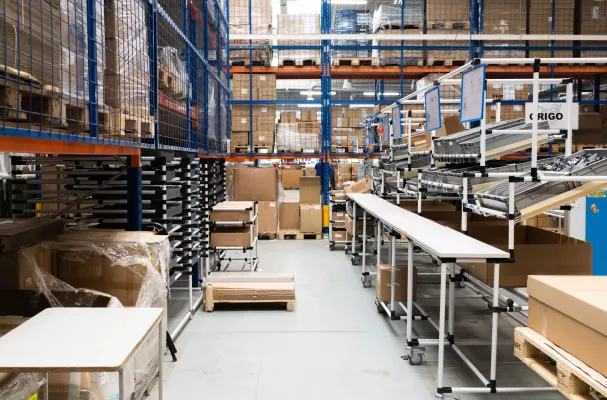"From 40 trucks, we wanted to increase production to 70. In the end, we can handle 115 of them per shift."
Read how we helped improve the manufacturing process using lean manufacturing. Not only did production go up, but valuable (and expensive) time and employee legs were saved. After the installation of the modular system, a fraction of what happened before takes place.
Lean implementation: 66% acceleration
Originally, the line for the production of cleaning carts was very simple and inefficient: 2 tables facing each other, around which everything took place. Two operators assembled the bases, a third repackaged the remaining pieces, and a fourth prepared the bags. Together, they put the final pieces into boxes. They were constantly going to each other for parts.No supplies could fit on the table and material from 40 different boxes is needed for assembly. In short, no well-thought-out kit system.
Therefore, the main goal of implementing lean production was to reduce the time for all the actions that workers perform. Only thanks to this, it is possible to significantly shorten the overall production. In operation, they recorded the times of individual operations, and thanks to this, they found that for one specific operation, after the introduction of lean production, they went from 450 seconds to 300. And it is exactly these seconds that they make extra pallets at the end of the shift.
"We completely canceled going for material, it was pointless. And at the end of the shift, or at night, we store for the next day," says the process engineer."Today, all employees are standing still and everything is moving around them," he adds.
"We presented the results at the headquarters in Germany and everyone was enthusiastic. We will even make lean manufacturing a corporate standard in some parts of the process."
How lean manufacturing is put into practice
In this case, the first impulse for change was the new production manager, who had already worked with the lean production solution. Together with other colleagues, they wrote the work process and all the input materials that are used on the line. The Enprag team came to see the place and proposed the best solution with the designer. This, with a slight adjustment, was implemented.
"We wanted to be sure that the investment was worth it, so we did a test. We built five tables in a row, basically a full-scale model of the new line. We tested how long it would take to assemble the cart. Already on 15 pieces, we found out that we are able to get to a faster time than we have now without much practice. And we counted on the fact that female operators with experience would get to an even faster time than us."
They went from 4 people and 40 products per shift to 3 operators and 115 products in operation. In addition, they praise how easily they can set up and adjust the line. The tubular modular systems adapt exactly to your work.
